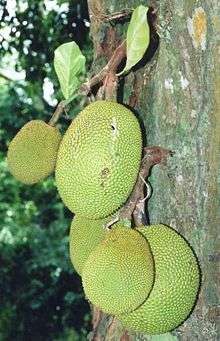Cauliflory

Flowers growing from the hard and woody horizontal stem of a Watermelon Tree, Australia

Jackfruits growing directly from the trunk
Cauliflory is a botanical term referring to plants which flower and fruit from their main stems or woody trunks rather than from new growth and shoots. This can allow trees to be pollinated or have their seeds dispersed by animals which cannot climb or fly. [1] With fruit, plants may instead have fruit which drop from the canopy and ripen only after they reach the ground, an alternative "strategy" to cauliflory.[1]
The word comes from the Latin language caulis (=trunk or stem) with the suffix -flory (=flower)
Examples
Genus Ficus
- Ficus racemosa – Cluster Fig, Figwood, Goolar (Gular) Fig (Australia, SE Asia, Indian subcontinent and Malesia).
- Ficus sansibarica
- Ficus sur
- Ficus sycomorus
Other
- Syzygium moorei – Coolamon, Durobby, Rose Apple, Watermelon Tree (Australia)
- Syzygium cormiflorum – White Apple, Wild Apple, Watergum, Cairns Satinash, Bumpy Satinash (N.E. Australia)
- Cacao and the rest of the genus Theobroma
- Cola
- Crescentia and Amphitecna, the "calabash tree".
- Cempedak
- Cercis (Redbud)
- Dysoxylum spp. including D.parasiticum and D.spectabile
- False soap-berry
- Jabuticaba
- Jackfruit
- Papaya
- Natal ironplum
- Stamvrug
- Tree fuchsia
- Uvariopsis
See also
References
- 1 2 Jeremy M.B. Smith. "Tropical forest: Population and community development and structure: Relationships between the flora and fauna -- Encyclopædia Britannica". Retrieved 2008-03-07.
External links
| Wikimedia Commons has media related to Cauliflory. |
| Look up cauliflory in Wiktionary, the free dictionary. |
This article is issued from
Wikipedia.
The text is licensed under Creative Commons - Attribution - Sharealike.
Additional terms may apply for the media files.